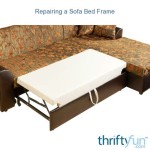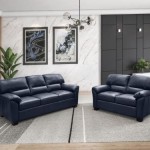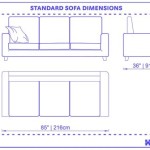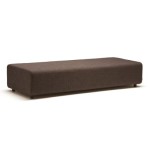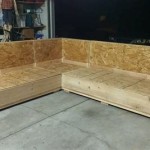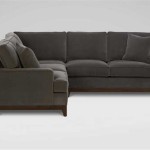Difference Between Sofa and Sectional: Understanding Your Seating Options
Selecting the right seating for a living room or common space requires careful consideration of factors such as room size, seating needs, and aesthetic preferences. Two of the most popular choices are sofas and sectionals, each offering distinct advantages and disadvantages. Understanding the key differences between these furniture pieces is crucial for making an informed decision that aligns with individual requirements and spatial constraints.
While both sofas and sectionals serve the fundamental purpose of providing seating, they differ significantly in their construction, size, configuration, and overall impact on a room's design. A sofa is generally a single, self-contained unit designed to seat multiple people. A sectional, on the other hand, comprises multiple independent units that are joined together to create a larger, more expansive seating area. This modular nature provides greater flexibility in terms of arrangement and configuration.
The choice between a sofa and a sectional ultimately depends on a variety of factors specific to the individual and the space. Examining the distinctions in size and space utilization, design and configuration options, and functionality and versatility will aid in determining the most suitable option.
Size and Space Utilization
One of the primary considerations when choosing between a sofa and a sectional is the size of the room and the amount of seating required. Sofas are typically smaller and more compact than sectionals, making them suitable for smaller living rooms, apartments, or offices. They can fit comfortably against a single wall and leave ample space for other furniture pieces, such as coffee tables, side tables, and armchairs. The standardized dimensions of a sofa generally range from 70 to 90 inches in width, offering seating for two to three people comfortably. This smaller footprint allows for easier navigation within the room and a more open, airy feel.
Sectionals, in contrast, are significantly larger and designed to accommodate larger groups of people. They are often used in spacious living rooms, family rooms, or media rooms where ample seating is desired. A sectional can extend along multiple walls or even wrap around a corner, maximizing the available seating space. The overall dimensions of a sectional vary depending on the number of sections and the configuration, but they can easily exceed 100 inches in both width and depth. While a sectional can provide ample seating for a large family or frequent gatherings, it can also dominate a smaller room, making it feel cramped and cluttered. Therefore, carefully measuring the available space and planning the layout is essential before purchasing a sectional.
Consideration should be given not only to the overall dimensions but also to the flow of traffic within the room. A large sectional can obstruct pathways and make it difficult to move around the space comfortably. In smaller rooms, a sofa may be a more practical option as it allows for better traffic flow and a more functional layout. In larger rooms, a sectional can be strategically placed to define different zones within the space, such as a seating area and a reading nook.
The height and depth of both sofas and sectionals also contribute to their perceived size and impact on the room. A sofa with a high back and deep seat will appear larger and more imposing than a sofa with a low back and shallow seat. Similarly, a sectional with thick, bulky cushions will take up more visual space than a sectional with sleek, minimalist cushions. Choosing a sofa or sectional with proportions that are appropriate for the room size is crucial for creating a balanced and harmonious design.
Design and Configuration Options
The design and configuration possibilities offered by sofas and sectionals differ considerably. Sofas typically present a more unified and straightforward aesthetic. They are generally available in a limited range of styles, from classic and traditional to modern and contemporary. While the overall design of a sofa may vary, the basic structure remains consistent: a single, self-contained unit with a back, seat, and arms. This simplicity makes sofas easy to integrate into a variety of design schemes, from formal living rooms to casual family rooms.
Sectionals, on the other hand, offer a much wider range of design and configuration options. The modular nature of sectionals allows for customization to fit specific room layouts and personal preferences. Sectionals are comprised of multiple individual pieces, such as armless chairs, corner pieces, and ottomans, which can be arranged in various configurations to create different seating arrangements. Common sectional configurations include L-shaped, U-shaped, and semi-circular designs. The choice of configuration depends on the size and shape of the room, as well as the desired seating capacity.
Beyond the basic configuration, sectionals also offer a variety of design options in terms of fabric, color, and style. They can be upholstered in a wide range of materials, from luxurious leather to durable microfiber. The color and pattern of the upholstery can be chosen to complement the existing decor or to create a bold statement. Sectionals are also available in a variety of styles, from traditional and formal to modern and minimalist. Some sectionals feature built-in features such as reclining seats, cup holders, and storage compartments, adding to their functionality and versatility.
The flexibility of sectional configurations allows for adaptation to changing needs and preferences. For example, a sectional can be reconfigured to accommodate different seating arrangements for different occasions. Individual pieces can be moved around to create a more intimate conversation area or to open up the space for a larger gathering. This adaptability makes sectionals a practical choice for families who frequently entertain or for individuals who like to rearrange their furniture on a regular basis.
However, the modular nature of sectionals can also present some challenges. It is important to ensure that the individual pieces are securely connected to prevent them from shifting or separating during use. Some sectionals come with connectors that are designed to hold the pieces together, while others rely on friction or weight to maintain their position. It is also important to consider the overall balance and symmetry of the sectional configuration to ensure that it looks aesthetically pleasing.
Functionality and Versatility
Sofas and sectionals differ in their functionality and versatility, catering to distinct lifestyle needs. Sofas primarily offer seating, but some models also incorporate additional features such as sleeper mechanisms or built-in storage. Sleeper sofas convert into a bed, providing a convenient option for accommodating overnight guests. Storage sofas feature compartments beneath the seat cushions, offering a practical solution for storing blankets, pillows, or other items.
Sectionals often provide greater functionality and versatility due to their modular design and larger size. Many sectionals include features such as reclining seats, adjustable headrests, and built-in consoles with cup holders and charging ports. These features enhance comfort and convenience, making sectionals a popular choice for media rooms or home theaters. Some sectionals also include ottomans, which can be used as footrests, extra seating, or coffee tables. The ottoman can be placed in front of the sectional to create a chaise lounge or moved around the room as needed.
The size and configuration of a sectional can also influence its functionality. A large, U-shaped sectional can create a more intimate and conversational seating area, while a smaller, L-shaped sectional can maximize space in a smaller room. The ability to rearrange the individual pieces of a sectional allows for customization to suit different activities and needs. For example, the sectional can be configured to create a comfortable seating area for watching movies, or it can be rearranged to create a more open space for socializing.
Furthermore, the design of a sectional can contribute to its functionality. Sectionals with low backs and wide seats are ideal for lounging and relaxing, while sectionals with high backs and firm cushions are better suited for formal seating. The choice of fabric also affects the functionality of a sectional. Durable, stain-resistant fabrics are a practical choice for families with children or pets, while luxurious fabrics such as velvet or leather are more suitable for formal living rooms.
The versatility of sectionals extends beyond their functional features. Sectionals can also be used to define different zones within a room. For example, a sectional can be placed to separate a living area from a dining area or to create a distinct seating area within a larger open space. The size and shape of the sectional can be used to visually divide the room and create a sense of separation between the different zones.
In summary, the choice between a sofa and a sectional hinges on various factors, including room size, seating requirements, design preferences, and desired functionality. A sofa is a compact and versatile option suitable for smaller spaces, while a sectional offers more seating and configuration options for larger rooms. Careful consideration of these differences is essential for selecting the right seating solution that meets individual needs and complements the overall design of the space.

5 Reasons Not To Choose A Sectional Sofa For Your Living Space Sawdust Sisters

Sectional Sofa 101 Everything To Know Before You Go Ping Wfmo

What Is A Sectional Ultimate Guide By Apt2b

Sectional Sofa Pieces What Do They All Mean The Stated Home Blog

Sectional Vs Sofa Showdown Choosing The Perfect Seating For Your Home Decorilla Interior Design

Types Of Sofas Sofa Vs Sectionals Bassett Furniture
What Is The Difference Between A Left Hand Facing Sectional Sofa And Right Quora

Sectional Sofa 101 Everything To Know Before You Go Ping Wfmo

What S The Difference Between Sofa And Couch

What Is The Difference Between Sofa And Couch Ottawa Furniture Blueprint Home

